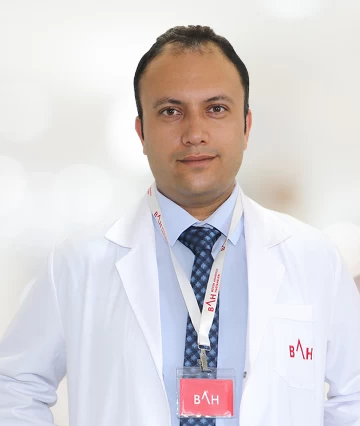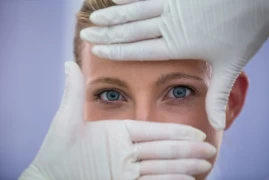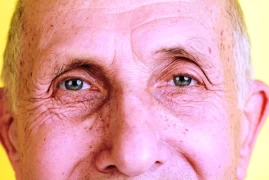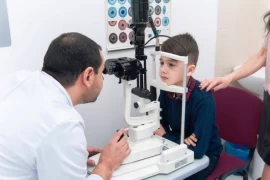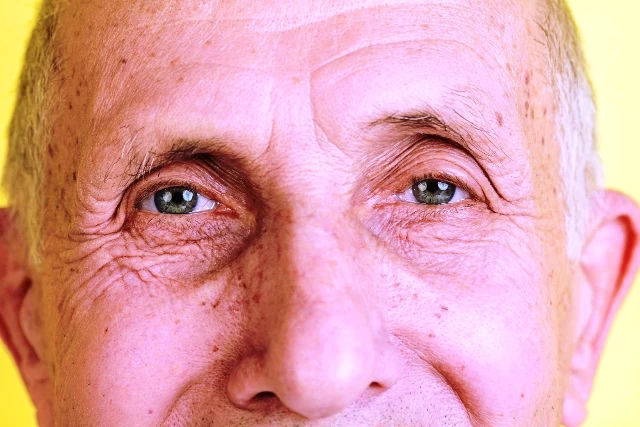
Age-Related Macular Degeneration
- Age-Related Macular Degeneration
- Age-Related Macular Degeneration
- Causes of Age-Related Macular Degeneration
- Types of Age-Related Macular Degeneration
- Symptoms of Age-Related Macular Degeneration
- Diagnosis of Age-Related Macular Degeneration
- Treatment Options for Age-Related Macular Degeneration
Age-Related Macular Degeneration (AMD), is an eye condition that affects the central vision by damaging the macula, the central part of the eye. In this article, I will cover topics such as what AMD is, its types, symptoms, causes, risk factors, diagnostic methods, and treatment options.
Age-Related Macular Degeneration
Age-Related Macular Degeneration (AMD) is an eye disease in which the central vision becomes blurred due to damage to the macula, the central part of the eye. The macula contains photoreceptor cells that provide sharp vision and color perception. AMD typically occurs in individuals over the age of 50 and is a result of the aging process.
Causes of Age-Related Macular Degeneration
AMD is a disease that is not fully understood, and its causes are complex. However, research suggests that the development of AMD could be influenced by the interaction of genetic predisposition and environmental factors. Here are some possible causes:
- Aging: AMD is a disease that develops with age. As you age, changes and damage occur in the cells of the macula region. Aging is a fundamental factor that increases the risk of AMD.
- Genetic Factors: Family history can influence the risk of AMD. Individuals with a family history of AMD from parents or grandparents may be at risk of developing the disease. Various genes are believed to contribute to an increased risk of AMD.
- Smoking: Smoking significantly increases the risk of AMD. Chemicals in cigarette smoke could affect eye blood vessels and contribute to the development of AMD.
- Nutrition: Unhealthy dietary habits, particularly insufficient intake of antioxidants (vitamins A, C, E) and carotenoids (such as lutein and zeaxanthin), can increase the risk of AMD.
- UV Radiation: Prolonged exposure to sunlight or artificial UV light can negatively affect eye health. Eyes are not designed to protect against harmful UV rays, and these rays can damage the macula.
- Blue Light Spectrum: Blue light can have harmful effects and damage cells in the macula. Blue light, especially from digital devices, can pose a potential risk with prolonged exposure.
- Cardiovascular Factors: Cardiovascular issues such as high blood pressure, high cholesterol, and obesity can increase the risk of AMD. These conditions can affect the vascular health of the eyes.
While the above factors can increase the risk of AMD, the exact causes of the disease are not yet fully understood. However, adopting a healthy lifestyle, avoiding smoking, providing sun protection for the eyes, and maintaining a balanced diet can help reduce the risk of AMD.
Types of Age-Related Macular Degeneration
AMD is classified into two main types:
- Dry Age-Related Macular Degeneration: Dry AMD is characterized by cellular atrophy and pigment accumulation in the macula. In this type, the nourishment of the macula becomes difficult, and cells gradually die. As a result, vision loss develops slowly.
- Wet Age-Related Macular Degeneration: Wet AMD is a condition where abnormal blood vessels grow towards the macula and leak. These vessels can leak fluid and blood, rapidly leading to vision loss by damaging the macula.
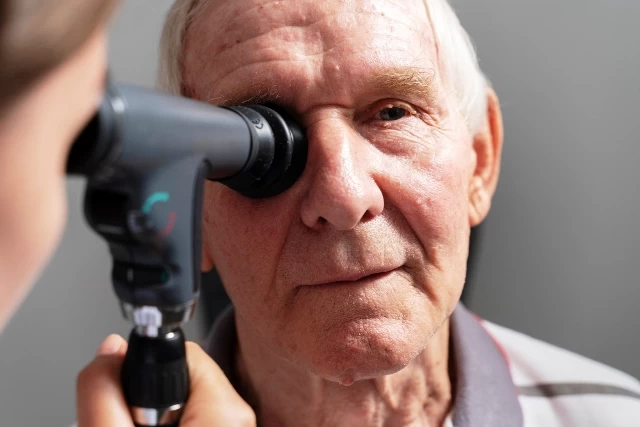
Symptoms of Age-Related Macular Degeneration
The symptoms of AMD typically develop slowly and can significantly impact an individual's quality of life. Early symptoms of AMD can include:
- Blurriness or Distortion of Central Vision: One of the most noticeable symptoms is blurriness, distortion, or darkening of central vision. Individuals may have difficulty seeing faces, text, or other details clearly.
- Metamorphopsia: Straight lines of objects may appear curved or wavy. This phenomenon is called "metamorphopsia" and can become more pronounced as AMD progresses.
- Difficulty with Color Perception: Some individuals may struggle to distinguish colors. It may become challenging to differentiate details, especially in pale colors.
- Dark Spots or Blank Areas: Dark spots or scotomas that form in the central region of the eye can disrupt the field of vision. This can particularly affect the ability to see objects.
- Poor Night Vision: Night vision may worsen as AMD advances, making it difficult to discern objects in low-light conditions.
If you are experiencing one or more of these symptoms, it is recommended to consult an eye doctor. Early diagnosis and treatment are important to minimize or slow down the effects of AMD. An eye doctor can determine the presence and stage of AMD through eye examinations and imaging tests such as optical coherence tomography (OCT).
Diagnosis of Age-Related Macular Degeneration
AMD is usually diagnosed by an eye doctor through the following steps:
- Eye Examination: An eye doctor will first examine the patient's eyes thoroughly. During this examination, the eye doctor can assess the front segment of the eye (cornea, iris, lens) and the outer layer of the retina.
- Visual Tests: An eye doctor may conduct visual tests to evaluate the patient's visual acuity. These tests measure the patient's ability to read letters or numbers.
- Amsler Grid Test: This test can help identify any distortion or deformation in central vision. Patients may observe that straight lines or squares appear bent or curved.
- Optical Coherence Tomography (OCT): This imaging technique is used to examine the layers and structure of the macula in detail. Through this, the eye doctor can determine the type (dry or wet) and stage of macular degeneration.
- Fundus Fluorescein Angiography: This test is used to obtain images of the blood vessels in the retina. It can help detect conditions associated with abnormal blood vessel growth, such as wet AMD.
- Computed Tomography (CT) or Magnetic Resonance Imaging (MRI): These imaging methods allow for more detailed visualization of the retina and structures behind the eye. However, they are generally used after other tests and especially for specific cases.
Based on the results of these tests, the eye doctor can diagnose the patient with Age-Related Macular Degeneration. After diagnosis, an appropriate treatment and management plan can be developed based on the type and stage of AMD. Regular eye check-ups are important for monitoring the progression of AMD and guiding treatment decisions.
Treatment Options for Age-Related Macular Degeneration
Currently, there is no definitive cure for AMD. However, some treatment options and management strategies can be used to slow down the progression or alleviate symptoms. Treatment approaches may vary based on the type (dry or wet) and stage of AMD.
- Dry Age-Related Macular Degeneration (Atrophic AMD): Treatment options for dry AMD generally aim to slow down the progression of the disease:
- Regular Eye Check-Ups: Regular monitoring by an eye doctor is essential to track disease progression and evaluate treatment options when necessary.
- Nutritional Supplements: Some studies suggest that nutritional supplements containing antioxidants (vitamins A, C, E) and carotenoids (such as lutein and zeaxanthin) can slow the progression of dry AMD.
- Wet Age-Related Macular Degeneration (Neovascular AMD): Treatment for wet AMD aims to control abnormal blood vessel growth and reduce the risk of visual loss:
- Anti-VEGF Drugs: These drugs aim to block the effect of a protein called VEGF (Vascular Endothelial Growth Factor) that promotes abnormal blood vessel growth. These drugs are injected into the eye and can halt or slow down abnormal vessel growth.
- Laser Treatment: Laser treatment for wet AMD targets abnormal blood vessels to destroy them. However, this treatment option is less commonly used compared to dry AMD.
Treatment options can vary based on the patient's condition, the type of AMD, and the patient's overall health. It is important to have a detailed discussion with your doctor about the effectiveness and risks of treatment methods. Early diagnosis, regular eye check-ups, and healthy lifestyle habits (avoiding smoking, maintaining a healthy diet, sun protection) can help manage the progression of Age-Related Macular Degeneration.
